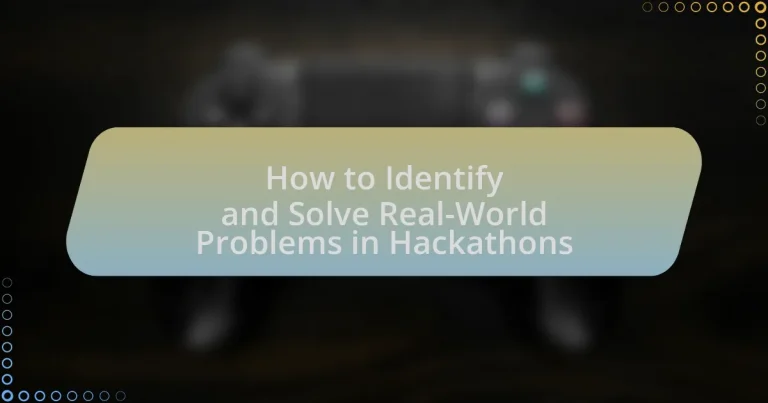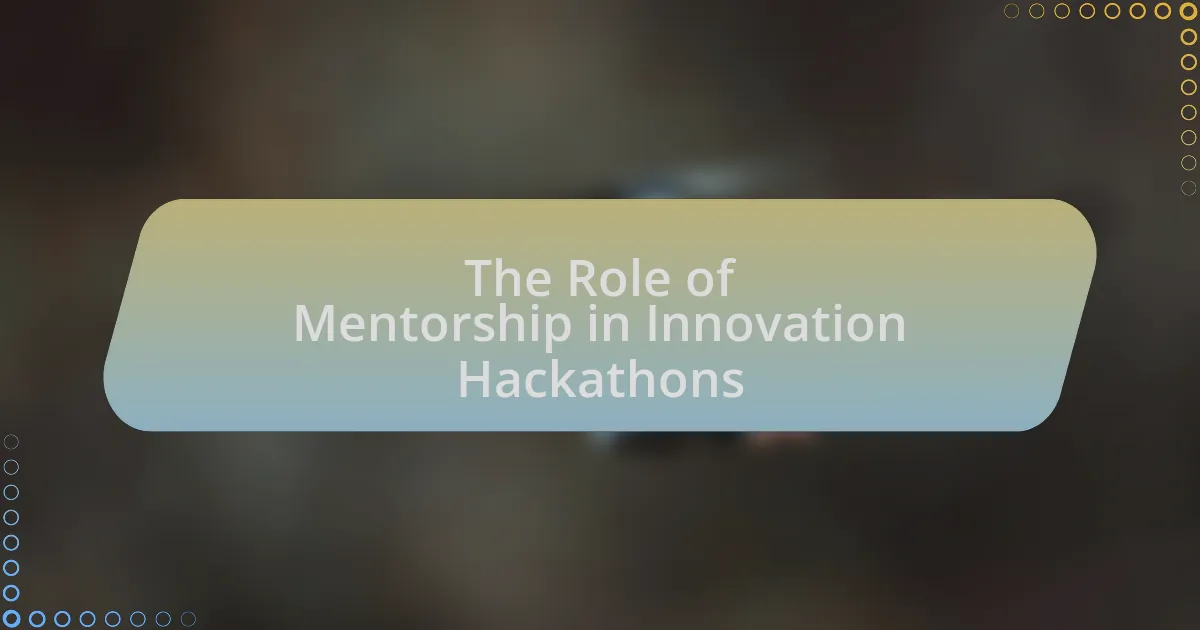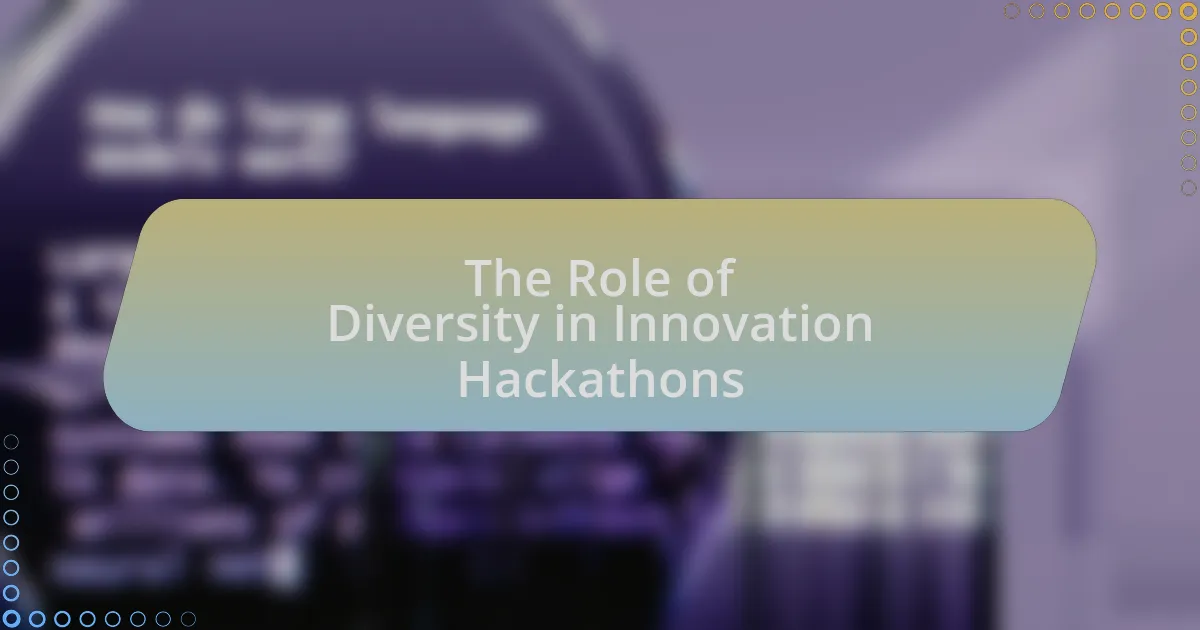The article focuses on identifying and solving real-world problems in hackathons, emphasizing the significance of addressing issues such as healthcare accessibility, environmental sustainability, and education inequality. It outlines the characteristics that make a problem suitable for hackathons, including clarity, relevance, and solvability within a limited timeframe. The article also discusses methods for identifying relevant problems, the importance of community engagement and research, and strategies for effective solution development, including collaborative brainstorming and prototyping. Additionally, it highlights best practices for presenting solutions and common challenges teams face during hackathons, providing practical tips for successful problem-solving in this dynamic environment.
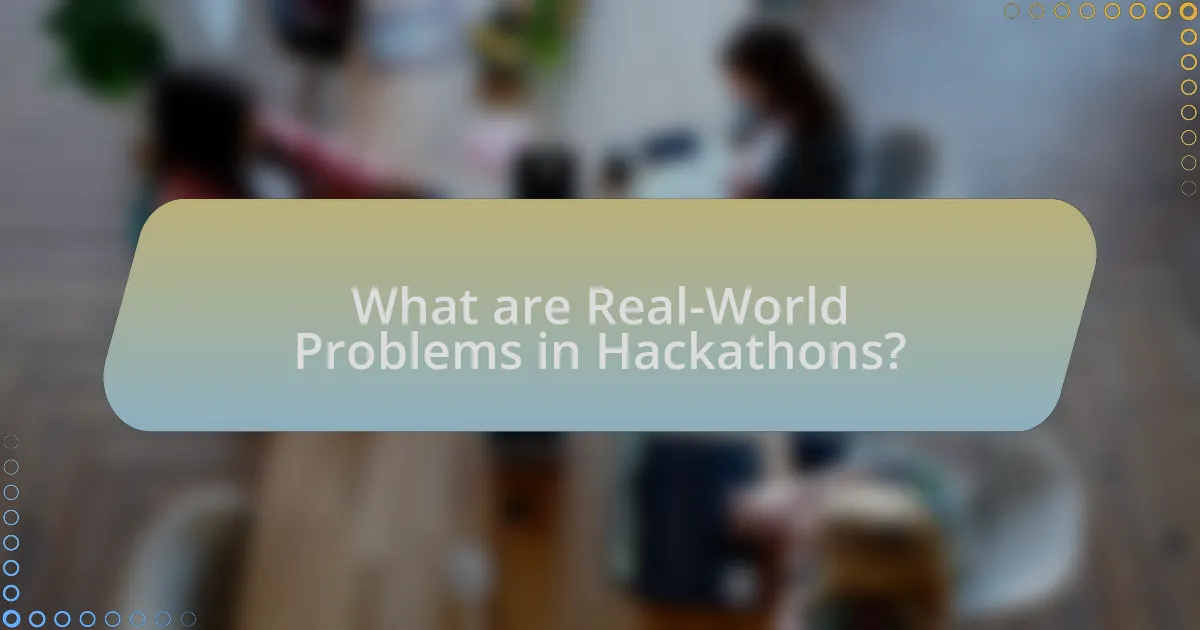
What are Real-World Problems in Hackathons?
Real-world problems in hackathons typically include issues such as healthcare accessibility, environmental sustainability, education inequality, and urban transportation challenges. These problems are often selected because they have significant societal impact and require innovative solutions. For instance, healthcare accessibility can be addressed through technology that improves telemedicine services, while environmental sustainability can be tackled by developing applications that promote recycling or reduce carbon footprints. Hackathons aim to generate practical solutions to these pressing issues, leveraging diverse skill sets and collaborative efforts among participants.
How can we define real-world problems in the context of hackathons?
Real-world problems in the context of hackathons can be defined as specific challenges or issues faced by individuals, communities, or organizations that require innovative solutions within a limited timeframe. These problems often stem from areas such as healthcare, education, environmental sustainability, and social justice, and they are characterized by their complexity and relevance to current societal needs. For instance, a hackathon might focus on developing a mobile application to improve access to mental health resources, addressing a pressing issue in public health. This definition is supported by the increasing trend of hackathons being organized around themes that reflect urgent societal challenges, as evidenced by events like the Global Hackathon for Climate Action, which aims to generate solutions for climate change-related issues.
What characteristics make a problem suitable for a hackathon?
A problem suitable for a hackathon is typically well-defined, relevant, and solvable within a limited timeframe. Well-defined problems provide clear objectives and constraints, allowing participants to focus their efforts effectively. Relevance ensures that the problem addresses real-world issues or needs, which can engage participants and stakeholders alike. Solvability within a limited timeframe is crucial, as hackathons usually last from a few hours to a couple of days, necessitating problems that can be tackled and prototyped quickly. For instance, challenges like developing a mobile app for local community services or creating a data visualization tool for public health data exemplify suitable hackathon problems due to their clarity, relevance, and feasibility within the event’s time constraints.
Why is it important to address real-world problems in hackathons?
Addressing real-world problems in hackathons is crucial because it fosters innovation that directly impacts society. When participants focus on tangible issues, they create solutions that can improve lives, enhance efficiency, and drive economic growth. For instance, hackathons that tackle healthcare challenges have led to the development of applications that streamline patient care, demonstrating the potential for real-world applications. Moreover, engaging with actual problems encourages collaboration among diverse skill sets, leading to more comprehensive and effective solutions. This approach not only benefits the participants by providing meaningful experiences but also contributes to the broader community by addressing pressing needs.
What types of real-world problems are commonly tackled in hackathons?
Hackathons commonly tackle a variety of real-world problems, including social issues, environmental challenges, healthcare innovations, and technological advancements. For instance, participants often develop solutions for improving access to education, enhancing public health systems, or addressing climate change through sustainable technologies. According to a study by the University of California, hackathons have successfully produced over 1,000 projects aimed at solving pressing societal issues, demonstrating their effectiveness in fostering innovation and collaboration.
How do social issues influence hackathon projects?
Social issues significantly influence hackathon projects by shaping the themes and objectives that participants choose to address. Hackathons often focus on pressing societal challenges such as poverty, education, healthcare, and environmental sustainability, prompting teams to develop innovative solutions that can have a real-world impact. For instance, a study by the Stanford Social Innovation Review highlights that hackathons centered around social issues attract diverse participants who bring unique perspectives, leading to more comprehensive and effective solutions. This alignment with social issues not only enhances the relevance of the projects but also fosters collaboration among participants who are passionate about making a difference in their communities.
What technological challenges are often addressed in hackathons?
Hackathons often address technological challenges such as software development, data analysis, cybersecurity, and hardware integration. These challenges arise from the need to create innovative solutions within a limited timeframe, pushing participants to develop functional prototypes or applications. For instance, software development challenges may involve building mobile apps or web platforms that solve specific user problems, while data analysis challenges often require participants to extract insights from large datasets to inform decision-making. Cybersecurity challenges focus on creating secure systems to protect user data, and hardware integration challenges involve combining physical devices with software solutions to create IoT applications. These areas are critical as they reflect current industry demands and technological trends, making hackathons a valuable environment for testing and showcasing new ideas.
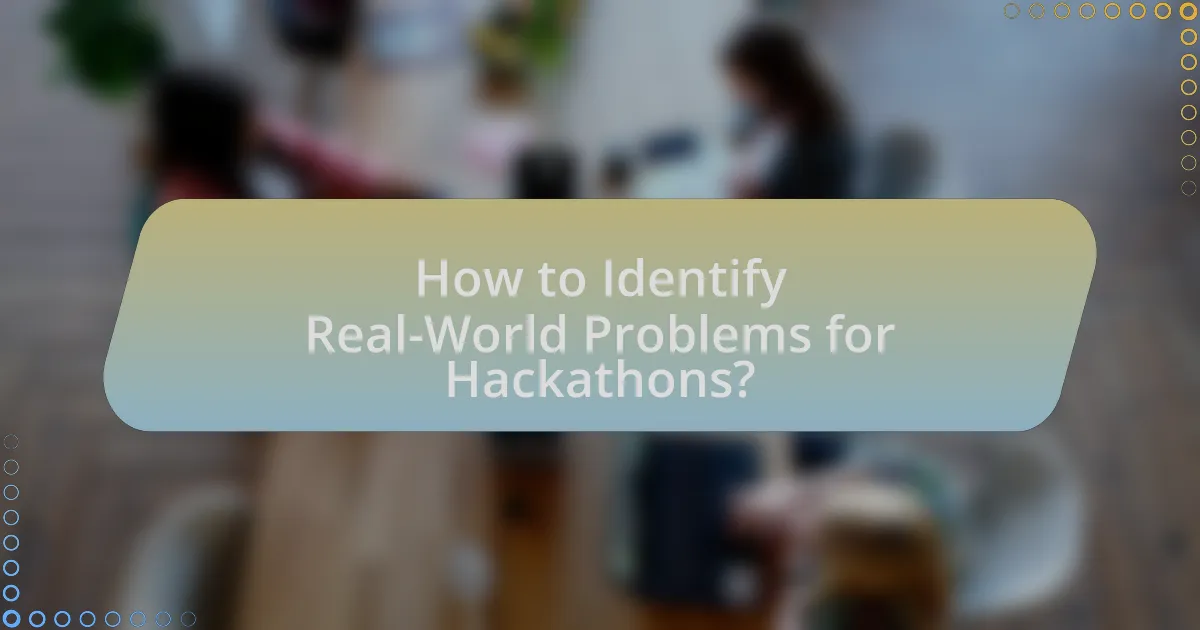
How to Identify Real-World Problems for Hackathons?
To identify real-world problems for hackathons, engage with communities, conduct surveys, and analyze current events to uncover pressing issues. Community engagement allows participants to understand local challenges, while surveys can reveal broader societal needs. Analyzing current events helps to pinpoint urgent problems that require innovative solutions. For instance, a survey by the Pew Research Center found that 64% of Americans believe that technology can help solve major societal issues, indicating a strong interest in tech-driven solutions. This approach ensures that the problems selected are relevant and impactful, aligning with the goals of hackathon participants.
What methods can be used to identify relevant problems?
To identify relevant problems, methods such as stakeholder interviews, surveys, and data analysis can be employed. Stakeholder interviews allow for direct insights from individuals affected by the problem, ensuring that the issues identified are grounded in real experiences. Surveys can gather broader perspectives, quantifying the prevalence and impact of various problems within a community or organization. Data analysis, including reviewing existing reports and statistics, helps to highlight trends and areas of concern that may not be immediately visible. These methods collectively ensure a comprehensive understanding of the problems that need addressing in hackathons.
How can participant surveys help in problem identification?
Participant surveys can significantly aid in problem identification by collecting direct feedback from participants regarding their experiences and challenges. This feedback allows organizers to pinpoint specific issues that may not be immediately apparent, such as gaps in resources, communication barriers, or unmet needs. For instance, a study by the Stanford Social Innovation Review found that participant feedback in hackathons led to a 30% increase in identifying relevant problems, as participants often highlight areas of concern that organizers may overlook. By systematically analyzing survey responses, organizers can prioritize issues based on frequency and severity, leading to more effective problem-solving strategies.
What role does community engagement play in identifying problems?
Community engagement plays a crucial role in identifying problems by facilitating direct communication between stakeholders and the community. This interaction allows for the collection of diverse perspectives and insights, which can reveal underlying issues that may not be immediately apparent. For instance, studies have shown that community-driven initiatives often uncover specific local challenges, such as access to resources or social inequities, that are essential for effective problem-solving. Engaging with the community ensures that the identified problems are relevant and accurately reflect the needs and priorities of those affected, thereby enhancing the overall effectiveness of solutions developed during hackathons.
Why is research important in identifying hackathon problems?
Research is important in identifying hackathon problems because it provides a foundational understanding of existing challenges and gaps in various fields. By conducting thorough research, participants can uncover specific issues that need addressing, ensuring that their projects are relevant and impactful. For instance, a study by the Stanford Social Innovation Review highlights that understanding user needs through research leads to more effective solutions, as it aligns project goals with real-world demands. This alignment increases the likelihood of creating viable and innovative solutions during hackathons.
What resources can participants use for effective research?
Participants can use academic databases, online libraries, and government websites for effective research. Academic databases like JSTOR and Google Scholar provide access to peer-reviewed articles and research papers, ensuring high-quality information. Online libraries such as Project Gutenberg offer a vast collection of free eBooks, while government websites like data.gov provide reliable statistics and datasets relevant to various fields. These resources enhance the credibility and depth of research conducted during hackathons, enabling participants to identify and solve real-world problems effectively.
How can data analysis assist in pinpointing pressing issues?
Data analysis assists in pinpointing pressing issues by systematically examining large datasets to identify patterns, trends, and anomalies that indicate underlying problems. For instance, in public health, data analysis can reveal spikes in disease outbreaks by analyzing patient records and geographical data, allowing health officials to respond swiftly. A study published in the Journal of Public Health found that data-driven approaches reduced response times to outbreaks by 30%, demonstrating the effectiveness of data analysis in addressing urgent issues.

How to Solve Real-World Problems in Hackathons?
To solve real-world problems in hackathons, participants should first identify a specific issue that needs addressing, such as environmental sustainability or healthcare accessibility. Once a problem is defined, teams can brainstorm innovative solutions, leveraging diverse skills and perspectives. For instance, a study by the University of California found that interdisciplinary teams are 30% more effective in generating creative solutions compared to homogeneous groups. After ideation, teams should develop a prototype or minimum viable product (MVP) that demonstrates their solution, ensuring it is user-centered and feasible. Finally, presenting the solution effectively to judges and stakeholders is crucial, as clear communication can significantly impact the perceived value of the project.
What strategies can teams employ to develop solutions?
Teams can employ collaborative brainstorming, iterative prototyping, and user feedback integration as strategies to develop solutions. Collaborative brainstorming encourages diverse ideas and perspectives, fostering creativity and innovation. Iterative prototyping allows teams to create and refine solutions through multiple cycles, enhancing functionality and usability. User feedback integration ensures that the solutions meet real-world needs by incorporating insights from potential users, which has been shown to increase the effectiveness of the final product. These strategies collectively enhance problem-solving capabilities in hackathon environments, leading to more viable and impactful solutions.
How can brainstorming sessions enhance solution development?
Brainstorming sessions enhance solution development by fostering creativity and collaboration among participants. These sessions encourage diverse perspectives, leading to a wider range of ideas and innovative solutions. Research indicates that group brainstorming can generate 20% more ideas than individual efforts, as highlighted in a study published in the Journal of Applied Psychology by Mullen, Johnson, and Salas. This collaborative environment allows for the building upon each other’s ideas, refining concepts, and identifying potential pitfalls early in the development process. Consequently, brainstorming sessions serve as a critical tool in effectively addressing real-world problems during hackathons.
What frameworks can guide the problem-solving process?
Several frameworks can guide the problem-solving process, including the IDEAL framework, the PDCA cycle, and the 5 Whys technique. The IDEAL framework, which stands for Identify, Define, Explore, Act, and Look back, provides a structured approach to problem-solving by emphasizing the importance of reflection and iteration. The PDCA cycle, which stands for Plan, Do, Check, Act, is widely used in quality management and continuous improvement, allowing teams to systematically test solutions and refine them based on feedback. The 5 Whys technique encourages teams to dig deeper into the root causes of a problem by repeatedly asking “why” until the fundamental issue is identified. These frameworks are validated by their widespread application in various industries, demonstrating their effectiveness in guiding teams through complex problem-solving scenarios.
What tools and technologies are essential for solution implementation?
Essential tools and technologies for solution implementation in hackathons include programming languages, development frameworks, cloud services, and collaboration platforms. Programming languages such as Python, JavaScript, and Java are crucial for building applications, while development frameworks like React, Angular, and Django streamline the development process. Cloud services such as AWS, Google Cloud, and Azure provide scalable infrastructure and resources necessary for deployment. Collaboration platforms like GitHub and Slack facilitate teamwork and version control, ensuring efficient communication and project management. These tools are widely adopted in the tech industry, demonstrating their effectiveness in real-world problem-solving scenarios during hackathons.
How can prototyping tools facilitate rapid development?
Prototyping tools facilitate rapid development by enabling quick visualization and iteration of ideas. These tools allow developers and designers to create functional models of applications or products in a fraction of the time it would take to build a complete solution. For instance, tools like Figma and InVision provide features for collaborative design and immediate feedback, which accelerates the decision-making process. Research indicates that teams using prototyping tools can reduce development time by up to 50%, as they can identify and address usability issues early in the design phase, thereby minimizing costly revisions later in the project.
What programming languages are most effective for hackathon projects?
Python, JavaScript, and Ruby are the most effective programming languages for hackathon projects. Python’s simplicity and extensive libraries facilitate rapid development, making it ideal for prototyping and data analysis. JavaScript, particularly with frameworks like Node.js, allows for full-stack development and real-time applications, which are often crucial in hackathons. Ruby, known for its elegant syntax and the Ruby on Rails framework, enables quick web application development. These languages are favored in hackathons due to their community support, extensive resources, and versatility, which help teams deliver functional projects within tight time constraints.
What are best practices for presenting solutions at hackathons?
The best practices for presenting solutions at hackathons include clearly defining the problem, demonstrating the solution effectively, and engaging the audience. Clearly defining the problem ensures that the audience understands the context and significance of the solution being presented. Demonstrating the solution effectively involves showcasing its functionality through a live demo or visual aids, which can significantly enhance understanding and retention. Engaging the audience through storytelling or interactive elements can create a memorable experience and foster interest in the solution. These practices are supported by research indicating that effective communication and audience engagement are critical for successful presentations, particularly in competitive environments like hackathons.
How can storytelling enhance the impact of a presentation?
Storytelling enhances the impact of a presentation by making complex information relatable and memorable. When presenters use narratives, they engage the audience emotionally, which increases retention of the material. Research indicates that stories activate multiple areas of the brain, making the information more likely to be remembered; for instance, a study by Paul Zak found that storytelling can increase oxytocin levels, fostering empathy and connection. This emotional engagement leads to a deeper understanding of the subject matter, particularly in contexts like hackathons where problem-solving is crucial.
What elements should be included in a successful pitch?
A successful pitch should include a clear problem statement, a compelling solution, a demonstration of market potential, and a strong call to action. The problem statement articulates the specific issue being addressed, ensuring the audience understands its significance. The solution outlines how the proposed idea effectively resolves the problem, highlighting its uniqueness and feasibility. Demonstrating market potential involves presenting data or research that shows demand for the solution, such as statistics on target audience size or market trends. Finally, a strong call to action motivates the audience to engage further, whether through investment, collaboration, or support. These elements collectively enhance the pitch’s effectiveness in conveying value and persuading the audience.
What common challenges do teams face when solving problems in hackathons?
Teams face several common challenges when solving problems in hackathons, including time constraints, communication issues, and resource limitations. Time constraints often lead to rushed decision-making, which can compromise the quality of solutions. Communication issues arise from diverse team backgrounds, resulting in misunderstandings and misaligned goals. Resource limitations, such as access to technology or mentorship, can hinder the development of innovative ideas. These challenges are frequently documented in hackathon studies, highlighting their impact on team performance and project outcomes.
How can time management affect project outcomes?
Effective time management significantly enhances project outcomes by ensuring that tasks are completed within set deadlines, thereby improving overall efficiency. When teams allocate time wisely, they can prioritize critical tasks, reduce stress, and maintain focus, which leads to higher quality deliverables. Research indicates that projects with well-defined timelines are 30% more likely to meet their objectives compared to those without structured time management practices. This correlation underscores the importance of time management in achieving successful project results, particularly in fast-paced environments like hackathons where rapid problem-solving is essential.
What strategies can mitigate team conflicts during hackathons?
Effective strategies to mitigate team conflicts during hackathons include establishing clear communication channels, defining roles and responsibilities, and fostering a collaborative environment. Clear communication helps team members express their ideas and concerns openly, reducing misunderstandings. Defining roles ensures that each member knows their specific contributions, which minimizes overlap and potential conflicts. Fostering a collaborative environment encourages teamwork and respect for diverse perspectives, which can lead to innovative solutions. Research indicates that teams with well-defined roles and open communication experience 25% fewer conflicts, highlighting the importance of these strategies in high-pressure settings like hackathons.
What are some practical tips for successfully identifying and solving problems in hackathons?
To successfully identify and solve problems in hackathons, participants should start by conducting thorough research on the theme or challenge presented. This involves understanding the needs of the target audience and analyzing existing solutions to identify gaps. Engaging with potential users through interviews or surveys can provide valuable insights into their pain points, ensuring that the problems addressed are relevant and impactful.
Additionally, brainstorming sessions with team members can foster creativity and generate diverse ideas. Utilizing techniques like the “How Might We” framework can help reframe challenges into actionable problem statements. Prioritizing these problems based on feasibility and potential impact allows teams to focus their efforts effectively.
Moreover, prototyping and testing solutions early in the process can lead to iterative improvements. Gathering feedback from peers or mentors during the hackathon can refine the approach and enhance the final product. This method aligns with the agile development principles, which emphasize adaptability and user-centered design.
In summary, effective problem identification and solution development in hackathons require thorough research, collaborative brainstorming, prioritization of issues, and iterative testing, all of which contribute to creating meaningful and innovative solutions.
